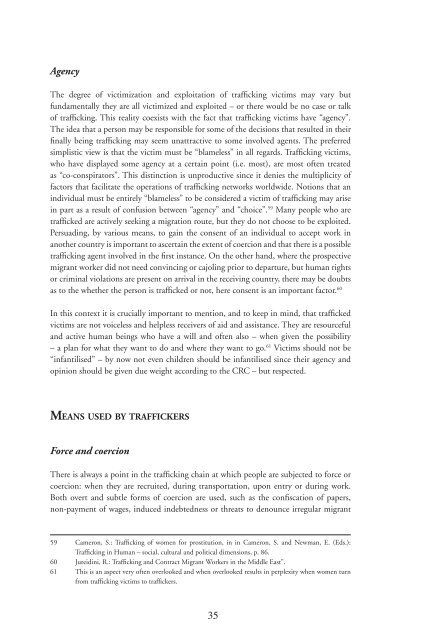Trafficking in human beings: human rights and ... - unesdoc - Unesco
Trafficking in human beings: human rights and ... - unesdoc - Unesco
Trafficking in human beings: human rights and ... - unesdoc - Unesco
You also want an ePaper? Increase the reach of your titles
YUMPU automatically turns print PDFs into web optimized ePapers that Google loves.
Agency<br />
The degree of victimization <strong>and</strong> exploitation of traffi ck<strong>in</strong>g victims may vary but<br />
fundamentally they are all victimized <strong>and</strong> exploited – or there would be no case or talk<br />
of traffi ck<strong>in</strong>g. This reality coexists with the fact that traffi ck<strong>in</strong>g victims have “agency”.<br />
The idea that a person may be responsible for some of the decisions that resulted <strong>in</strong> their<br />
fi nally be<strong>in</strong>g traffi ck<strong>in</strong>g may seem unattractive to some <strong>in</strong>volved agents. The preferred<br />
simplistic view is that the victim must be “blameless” <strong>in</strong> all regards. Traffi ck<strong>in</strong>g victims,<br />
who have displayed some agency at a certa<strong>in</strong> po<strong>in</strong>t (i.e. most), are most often treated<br />
as “co-conspirators”. This dist<strong>in</strong>ction is unproductive s<strong>in</strong>ce it denies the multiplicity of<br />
factors that facilitate the operations of traffi ck<strong>in</strong>g networks worldwide. Notions that an<br />
<strong>in</strong>dividual must be entirely “blameless” to be considered a victim of traffi ck<strong>in</strong>g may arise<br />
<strong>in</strong> part as a result of confusion between “agency” <strong>and</strong> “choice”. 59 Many people who are<br />
traffi cked are actively seek<strong>in</strong>g a migration route, but they do not choose to be exploited.<br />
Persuad<strong>in</strong>g, by various means, to ga<strong>in</strong> the consent of an <strong>in</strong>dividual to accept work <strong>in</strong><br />
another country is important to ascerta<strong>in</strong> the extent of coercion <strong>and</strong> that there is a possible<br />
traffi ck<strong>in</strong>g agent <strong>in</strong>volved <strong>in</strong> the fi rst <strong>in</strong>stance. On the other h<strong>and</strong>, where the prospective<br />
migrant worker did not need conv<strong>in</strong>c<strong>in</strong>g or cajol<strong>in</strong>g prior to departure, but <strong>human</strong> <strong>rights</strong><br />
or crim<strong>in</strong>al violations are present on arrival <strong>in</strong> the receiv<strong>in</strong>g country, there may be doubts<br />
as to the whether the person is traffi cked or not, here consent is an important factor. 60<br />
In this context it is crucially important to mention, <strong>and</strong> to keep <strong>in</strong> m<strong>in</strong>d, that traffi cked<br />
victims are not voiceless <strong>and</strong> helpless receivers of aid <strong>and</strong> assistance. They are resourceful<br />
<strong>and</strong> active <strong>human</strong> be<strong>in</strong>gs who have a will <strong>and</strong> often also – when given the possibility<br />
– a plan for what they want to do <strong>and</strong> where they want to go. 61 Victims should not be<br />
“<strong>in</strong>fantilised” – by now not even children should be <strong>in</strong>fantilised s<strong>in</strong>ce their agency <strong>and</strong><br />
op<strong>in</strong>ion should be given due weight accord<strong>in</strong>g to the CRC – but respected.<br />
MEANS USED BY TRAFFICKERS<br />
Force <strong>and</strong> coercion<br />
There is always a po<strong>in</strong>t <strong>in</strong> the traffi ck<strong>in</strong>g cha<strong>in</strong> at which people are subjected to force or<br />
coercion: when they are recruited, dur<strong>in</strong>g transportation, upon entry or dur<strong>in</strong>g work.<br />
Both overt <strong>and</strong> subtle forms of coercion are used, such as the confi scation of papers,<br />
non-payment of wages, <strong>in</strong>duced <strong>in</strong>debtedness or threats to denounce irregular migrant<br />
59 Cameron, S.: Traffi ck<strong>in</strong>g of women for prostitution, <strong>in</strong> <strong>in</strong> Cameron, S. <strong>and</strong> Newman, E. (Eds.):<br />
Traffi ck<strong>in</strong>g <strong>in</strong> Human – social, cultural <strong>and</strong> political dimensions, p. 86.<br />
60 Jureid<strong>in</strong>i, R.: Traffi ck<strong>in</strong>g <strong>and</strong> Contract Migrant Workers <strong>in</strong> the Middle East”.<br />
61 This is an aspect very often overlooked <strong>and</strong> when overlooked results <strong>in</strong> perplexity when women turn<br />
from traffi ck<strong>in</strong>g victims to traffi ckers.<br />
35

















